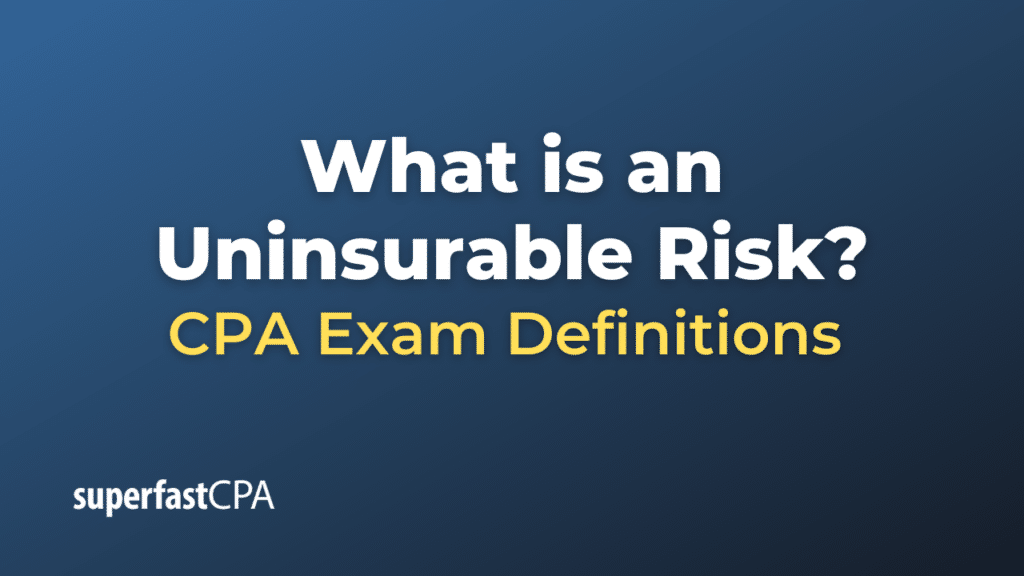Uninsurable Risk
Uninsurable risk refers to a hazard or condition that poses too high a level of uncertainty or potential for loss, making it difficult or impossible for an individual or entity to obtain insurance coverage for that particular risk. Insurance companies usually avoid underwriting uninsurable risks due to the lack of predictable data, extreme potential for loss, or moral or ethical considerations.
Types of Uninsurable Risks:
- Catastrophic Risks: These are extreme events like wars, nuclear explosions, or widespread natural disasters such as earthquakes and floods. The losses from such events are so massive and unpredictable that insurance companies cannot cover them.
- Speculative Risks: These are situations where there is a possibility of gain as well as loss. Examples include investments in the stock market or starting a new business. Most insurers do not cover speculative risks, as insurance is primarily designed to handle pure risks—situations where there’s a chance of loss or no loss, with no possibility of gain.
- Moral Hazards: These are risks arising from deliberate actions of the insured party. For instance, intentionally setting fire to one’s property to claim insurance benefits would fall under this category.
- Subjective Risks: These risks are perceived differently by different people and are difficult to quantify. For example, the risk of a supplier going out of business could be considered too subjective to insure.
- Legal Restrictions : Certain risks may be uninsurable because they involve activities that are illegal or against public policy.
- Lack of Insurable Interest: To get an insurance policy, the insured must have an insurable interest in the subject matter of the insurance. For example, you cannot insure a stranger’s life because you have no financial stake or insurable interest in it.
Implications:
- Self-Insurance: Businesses or individuals might have to bear the cost of such risks themselves or set aside a reserve to cover potential losses.
- Risk Mitigation : Since insurance isn’t available, other forms of risk mitigation become critical. This could include diversification, contingency planning, or avoidance of the activity that carries the risk.
- Public Sector Involvement: In some cases, like flood or earthquake risks in certain areas, the government might step in to provide some form of coverage.
- High Premiums : In cases where some form of insurance is available but considered very high-risk, premiums may be prohibitively expensive.
- Limited Coverage: Even if some part of the risk is insurable, the coverage may be limited and come with various exclusions.
By understanding what makes a risk uninsurable, both individuals and businesses can better plan for how to manage these types of risks.
Example of an Uninsurable Risk
Let’s consider a fictional example involving a small business owner, Emily, who owns a restaurant along a coastline prone to hurricanes.
Situation:
Emily’s restaurant is very successful, but she’s aware that the location is susceptible to hurricanes. While she has a standard business insurance policy, it doesn’t cover the losses that might occur due to a hurricane. Emily tries to get additional coverage specifically for hurricanes but finds that insurers either:
- Refuse to provide the coverage due to the high risk, deeming it an “uninsurable risk,” or
- Offer it at prohibitively high premiums that would make it economically unfeasible for her small business.
Types of Uninsurable Risks Involved:
- Catastrophic Risks: Hurricanes are categorized as catastrophic risks due to their massive scale and unpredictability, making it difficult for insurance companies to offer coverage.
- Lack of Insurable Interest : An insurer may argue that Emily chose to operate in a high-risk location and didn’t take adequate precautions, thus lacking a genuine “insurable interest.
Actions Emily Might Take:
- Self-Insurance: Emily could set aside a reserve fund specifically for potential hurricane-related damages. However, given the scale of destruction possible, this option might not cover all the losses.
- Risk Mitigation: She might invest in hurricane-resistant infrastructure for her restaurant. This could include reinforced windows, secure roofing, and flood barriers.
- Business Continuity Plan: Emily could develop a business continuity plan to ensure that her business could resume operations as quickly as possible after a hurricane.
- Government Programs: Emily could look into whether there are any government-backed insurance programs for natural disasters. These programs often provide limited coverage but could offer some relief.
- High Premiums: Although expensive, Emily could consider biting the bullet and paying for the high-premium, limited-coverage insurance, viewing it as a necessary cost of doing business in her chosen location.
- Relocation: A more drastic option would be relocating her restaurant to a less risky area, but this could mean losing her existing customer base and incurring significant moving costs.
Conclusion:
In this example, the risk associated with hurricanes is largely considered uninsurable due to its catastrophic nature and the high likelihood of occurrence in Emily’s location. This leaves Emily with the task of creatively managing this risk through various means, like self-insurance, risk mitigation techniques, or even participating in government programs designed for such extreme scenarios.













